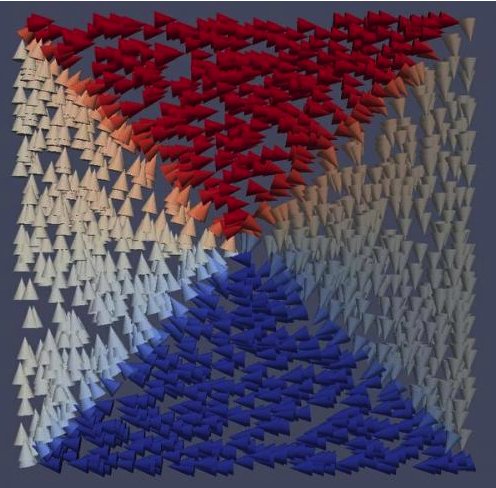DESY Scientists Film Magnetic Memory in Super Slow-Motion
For better understanding of dynamics of HDD materials
This is a Press Release edited by StorageNewsletter.com on December 2, 2014 at 2:57 pmScientists film magnetic memory in super slow-motion
Article from Phys.org
Researchers at Deutsche Elektronen-Synchrotron (DESY) have used high-speed photography to film one of the candidates for the magnetic storage devices of the future in action.

Illustration of magnetic field direction within memory cell
(Credit: Philipp Wessels/University of Hamburg)
The film was taken using an X-ray microscope and shows magnetic vortices being formed in ultrafast memory cells.
Their work, which has been reported by the scientists surrounding Dr. Philipp Wessels of the University of Hamburg in the journal Physical Review B, provides a better understanding of the dynamics of magnetic storage materials. Magnetic memory cells are found in every computer HDD.
“Our images allow us to observe in real time how exactly magnetisation evolves“, explains Wessels, from the research group of Prof. Markus Drescher at the Hamburg Centre for Ultrafast Imaging (CUI). “For the first time, we can observe the switching of these magnetic cells in detail.”
For their investigation, the researchers chose a memory cell made of an alloy of nickel and iron, which can be magnetised in less than a billionth of a second.
Their custom-built X-ray microscope, developed in association with a group headed by Prof. Thomas Wilhein at the Koblenz University of Applied Sciences, makes it possible for scientists to watch a memory cell being erased and then having new data written into it. The short pulses of X-rays produced by DESY’s synchrotron radiation source PETRA III give the images a temporal resolution of 0.2 billionths of a second (200 picoseconds). The degree of magnetisation can be measured via the extent to which the polarised X-ray radiation is absorbed by different regions of the sample. The X-ray microscope is able to distinguish minute details, down to 60 millionths of a millimetre (60 nanometres).
In their experiment, the scientists used tiny squares of the nickel-iron alloy, each side of which was two thousandths of a millimetre (2 micrometres) long. Each of the memory cells has four magnetic regions, so-called domains, whose magnetic field varies either in a clockwise or anti-clockwise direction. The individual magnetic domains are triangular, with their apexes meeting in the centre of the storage cell, producing a magnetic vortex core in the centre of the cell.
When the contents of the memory cell are erased by an external magnetic field, the magnetic vortex core is driven out of the cell.
“In our experiment, we were for the first time able to measure the speed at which the vortex cores are expelled from the material,” explains co-author Dr. Jens Viefhaus, who is in charge of the beamline P04, on which the experiments were conducted.
It turns out that the core is pushed out of the memory cell at over 3,600km per hour.
“Because this process is reproducible, we were able to make a reliable measurement of the velocity,” points out the CUI research scientist and associate professor Dr. Guido Meier. “In order to make these measurements, we had to use very intense and stable magnetic excitation pulses.“
The external magnetic field forces the entire memory cell into a state of uniform magnetisation. Once the field is switched off, the cell once again forms four magnetic domains with a central vortex – whose direction depends on that of the applied magnetic field; in other words, new data is written to the cell. The process is complex, however.
“The four-domain state develops via a complicated zigzag pattern, and for the first time we were able to watch ‘live’ as this state was formed,” reports Wessels.
The observed behaviour is in good agreement with the results of simulations. Thanks to the super-slow motion film, the high-speed dynamics of the process can now be viewed in greater detail.
“The same method can be used to study the dynamics of any other magnetic materials,” notes Wessels. “Our experiments can help us to understand how quickly data can, in principle, be written to a magnetic storage medium, coded in the form of domains.”
These investigations have practical implications for storage technology.
“Although laptops and other mobile devices these days are increasingly using non-magnetic storage technologies, such as flash memory, the price of magnetic storage devices means that there is no substitute for them when it comes to storing large amounts of data,” says Wessels. “The current trend is towards storing data in the cloud – and the cloud is magnetic.”
A better understanding of magnetisation dynamics can lead to faster and better storage media.
To explore further: Rare material key to computer advances
More information: Time-resolved imaging of domain pattern destruction and recovery via nonequilibrium magnetization states; Philipp Wessels, Johannes Ewald, Marek Wieland, Thomas Nisius, Andreas Vogel, Jens Viefhaus, Guido Meier, Thomas Wilhein and Markus Drescher; Physical Review B journal, 2014; DOI: 10.1103/PhysRevB.90.184417













 Subscribe to our free daily newsletter
Subscribe to our free daily newsletter
